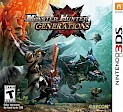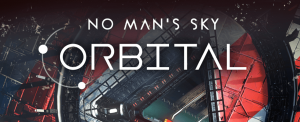Review: Monster Hunter Generations

Posted 12 Jul 2016 at 13:00 by Dennis Tummers
Hunting through the generations
After a long 8 months of waiting since the release of Monster Hunter X, the West is finally ready to join the hunt in Monster Hunter’s latest instalment, Monster Hunter Generations. As the title gives away, MHG is a game which celebrates all previous MH generations, going back to the very first game which released on the Playstation 2 in 2004. For those of you who have played Monster Hunter before this game needs no introduction. If you are new to franchise however, it may be good to know what the game (and series) is about.
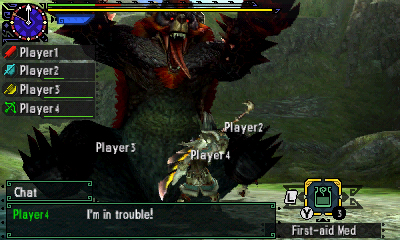 I'm in trouble, a thought which will cross your mind more than once...
I'm in trouble, a thought which will cross your mind more than once...
Monster Hunter is an action/adventure game with RPG elements. However, you do not level up. Instead, you gather more and more powerful gear in order to take on monsters, varying from sizes bug to leviathan. You start with weak weaponry and armour, but by gathering resources from flora and fauna (the latter is done by killing beasts and carving their carcasses for useful parts) you can upgrade your gear. This makes it possible to take on bigger monsters, which gives you better armour and weapons until you are taking on giant screenfilling monsters.
You can do this on your own (with help from some feline companions), or in local or online multiplayer with up to 4 players. As a new player all the weapons, quests, crafting options and finetuning can seem overwhelming, but it really pays off to dive in and explore all the different options. Luckily Monster Hunter Generations is fairly newbie-proof, with a lot of explanations and tutorials.
After checking out the great opening cinematic and doing some character customization, the game starts when your protagonist arrives in the cozy alpine-inspired village of Bherna. You are a young researcher/hunter working for the Wycademy, and your goal is to support the researchers in the area, for example by slaying beasts which are in the way of your research. Of course, it also helps the research by slaying these very monsters. Biology has never been so violent. Quickly you are sent on your first couple of quests, which traditionally lets you gather stuff from mushrooms to ferns, before you get a shot at whacking some small monsters, in order to get you familiar with the controls.
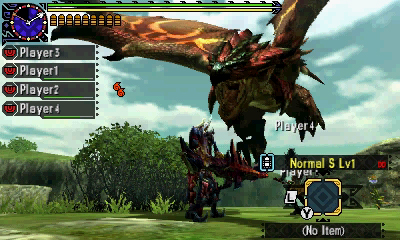 Ah Rathalos, we meet again. Off with that tail!
Ah Rathalos, we meet again. Off with that tail!
Veteran hunters will probably breeze through the first set of quests with ease. This however gives you a chance to explore the vast worlds of Monster Hunter Generations. There are some new worlds, but a lot of golden oldies also make their appearance, and already early in the game you will be exploring exotic regions such as Monster Hunter 4’s Dunes and Monster Hunter Tri’s Deserted Island. The old stages are tweaked a bit however. For example, Deserted Island used to contain a lot more water, but since swimming and underwater monsters are a no-go in Generations, these areas are either modified or completely gone. As a compensation, the stages contain added ridges for you to jump off in order to mount those pesky creatures.
Many of the monsters you encounter are familiar, especially if you have been playing the series for a long time. Yours truly started with Monster Hunter Tri on the Wii, but if you are an even more die-hard MH player you will recognize almost every creature in the game, since there is only a handful of new monsters to be found. One of these is the Malfestio, which you may know if you have played the demo. But for the rest it is mostly golden oldies in the monster line-up. On the one hand this brings the nostalgia level up in this game, and I couldn’t help but smile when I faced the mighty Lagiacrus again. Luckily this time without his annoying underwater moves! But fighting some monsters felt more like a drag, as I had my fair share of Royal Ludroth and Arzuros in the past.
The fighting however feels fresh thanks to a great new addition: Fighting Styles! Although the game lacks new types of weapons, it gives you Fighting Styles which add an immense layer of depth to your hunts. Basically, there are four types to choose from: Guild, Striker, Aerial and Adept. Each comes with its own combos, special tricks and gives you the option to use Hunter Arts. You can choose to play tactical with for example Aerial or Adept style. The first lets you bounce of players, monsters and bombs in order to jump and attack monsters from the sky, with a good chance at mounting. Adept gives you the option to last-minute dodge monster attacks, which needs real skill but gives you great advantages if timed correctly. Guild and Striker style focus more on the use of the also new Hunter Arts; special moves which can be used by filling your Hunter Arts gauge. These Arts differ per weapon, and range from supportive skills like Heal Gain (more effective health recovery), to insta-evasion moves, to powerful combos which pack a serious punch if timed right. You can activate them by using a key combination (or ZL and ZR on your New 3DS) or by using the touchscreen. Trying out every weapon with different Styles and Arts is a great incentive for using weapons which you usually did not use so much. I for example was never a big fan of the Sword and Shield, but it quickly became a favourite in this game due to the Arts.
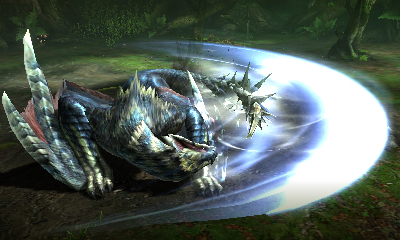 Unleash those Hunter Arts!
Unleash those Hunter Arts!
Talking about weapons. As said before, there are no new weapon types in the game. What is new however is the way of upgrading. Where at first you had to choose which path you would take in upgrading, you know need to level up your weapon with specific items (often ore). Each level unlocks a new path for the weapon, which then again can be upgraded further. This sounds complicated and it is indeed quite complicated, since you have to decide if you are going to waste resources on levelling up to see all options, or that you are taking a lower level path with the risk of missing out. Decisions decisions! The upside of this new upgrade method is that more upgrades are ore-based, and there are less upgrades demanding those rare monster parts, so you can cut down on the grinding. So you will be focussing a bit more on normal gathering.
Luckily gathering materials is also made easier in this game. Of course you are getting help again from some feline friends called Palicos (but more on them later). Further, once during a quest you can choose to send some items already back to base, which basically gives you plenty of room for gathering materials. Overall, this game feels as if they did a lot of things in order to keep the fun going. The fights feel easier (but maybe because a lot of monsters are already fought in previous instalments). Weapons can be upgraded faster without too much grinding. Gathering is less of a burden, and even in exploration quests your paw pass ticket is there from the very first second. This definitely is the easiest Monster Hunter game to date.
I was talking about Palicos earlier, and this brings me to maybe the best addition to the game. Where previously these furry guys were just there for support, it is now possible to crawl inside that furry skin and gallop around as a Palico yourself! Doing so is great fun, and brings some nice new elements to the table. For instance, these guys make for awesome gatherers, since they are weather resistant, don’t tire and gather bugs and minerals fast without the need for tools. In battle they can stand their ground by throwing boomerangs, and swinging knifes or clubs. In multiplayer they make for great support characters by using various skills which can boost or heal your team members. Or you can just annoy everyone by throwing bomb barrels in the middle of a close combat brawl. The catch is that these little guys cannot use items and are rather fragile, so you better think twice before you jump into a heated battle.
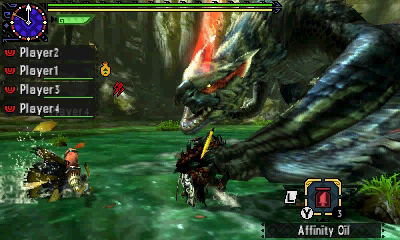 Meow this is going to hurt...
Meow this is going to hurt...
In online the addition of Palicos is even better, since it sort of introduces a real support character to the game. This was previously more a task of gunners and bow users, but the support moves from these cats add more variety to the game. The online part is as solid as it was in Monster Hunter 4 Ultimate. It is easy to set up or join rooms, and there are lots and lots of quests to do together. There weren't many people available to test multiplayer with, so my opinion on it is based on a few quests. But I can say that multiplayer is again a great part (maybe even the best part) of this game.
The content of this game is rich, with dozens and dozens of online and offline quests, and even more to come through (free!) DLC. There are more maps in this game than ever before, and it all runs on the smooth engine we know from Monster Hunter 4 Ultimate. The downside is that the number of cinematics is cut down, which is a shame since, as you can see in the opening animation, Capcom does really well. Also, the loading times feel slightly longer compared to previous 3DS games in the series. The game looks and feels the same as the previous instalment, although it seems to look a little bit more colourful. Further, there are some tweaks in the animations. The bottom screen is fully tuneable, and can show a lot of different things. Minimap, health bars, shortcuts to items or Hunter Arts, shortcuts for combining items et cetera. Just put in the tools which you find most useful.
If the game is not big enough for you, there is a ton of DLC coming your way
The game lacks some of the epicness of the previous titles. Where for example Monster Hunter 4 threw you right in an epic battle with an elder dragon, there is no real threat in Generations, no looming darkness or certain destruction hanging over your head. You just do your job finishing quests given to you in one of four villages, three which come from previous games. These quests are given to you by the locals, but also by visitors from other countries, and you will probably recognize a number of them when you have played previous instalments. As said before, this game is about nostalgia.
So on the one hand it is difficult to see this as a completely new game. It borrows the graphic engine from Monster Hunter 4, and a ton of the content (characters, monsters and areas) from previous games. The storytelling is almost absent and there are much less cutscenes. Then again, it brings some of the best changes in the series to the table by introducing playable Palicos and Fighting Styles. For me, this game feels like a bridge from the current generation (and probably the last one we see released on the 3DS) to the new. It wouldn’t surprise me if we see a Monster Hunter 5 release very soon after the Nintendo NX releases. For now Monster Hunter Generations is a game which can suck up insane amounts of your summer time, and probably also some autumn, winter and spring time. Personally, for me it comes a bit too soon after Monster Hunter 4 Ultimate, which I haven’t completed yet. And it takes some motivation to get grinding again until you get to the more interesting high ranks, especially with the recycled content. However, as a new player this game is a great start, as it is the most accessible, most content-rich Monster Hunter game and also lets you play through about 12 years of Monster Hunter history.
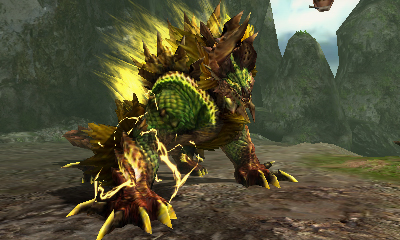
N-Europe Final Verdict
Monster Hunter Generations is a great celebration of all Monster Hunter generations. The game is filled to the brim with content focused on nostalgia, and introduces great new additions to the already solid gameplay. The lack of really new content and the reused MH4U engine however makes it sometimes feel more like a (really big) expansion rather than an all-new game. Still, this is a must have for new hunters and veterans alike.
- Gameplay4
- Playability4
- Visuals3
- Audio4
- Lifespan5
Final Score
9
Pros
Insane amount of content, both online and offline
Great new additions to play styles
Free DLC
Cons
Lack of new monsters
No real storyline and cinematics
Easier than previous instalments


